LINN — Linn native Cameron Gehlert, a 2018 Linn High School graduate now living in Washington, D.C., has always forged his own path, which recently culminated in a six-week pilgrimage to …
This item is available in full to subscribers.
We have recently launched a new and improved website. To continue reading, you will need to either log into your subscriber account, or purchase a new subscription.
If you are a current print subscriber, you can set up a free website account by clicking here.
Otherwise, click here to view your options for subscribing.
Please log in to continue |
|
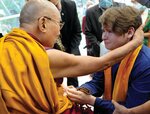
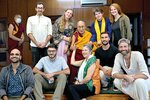
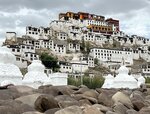

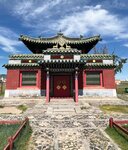
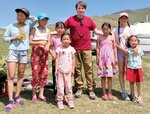

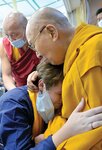
LINN — Linn native Cameron Gehlert, a 2018 Linn High School graduate now living in Washington, D.C., has always forged his own path, which recently culminated in a six-week pilgrimage to Mongolia, Dharamshala, in northern India where he had a rather close visit in June with His Holiness, the 14th Dalai Lama, and Ladakh.
Gehlert’s summer trip began with Mongolia and was eye-opening. The country is twice the size of Texas but has just three million inhabitants, with two million in one city, Ulaanbaatar, previously anglicized as Ulan Bator. “The rest are nomads,” Gehlert explained. “I wanted to tour the place. There are so many holy places in Mongolia, which has been a Buddhist nation for the majority of its history after Genghis Khan.”
Gehlert has a friend and spiritual teacher who was a student of the former head of Mongolian Buddhism, the ninth Khalkha Jetsun Dampa Rinpoche, who wasn’t recognized until 1991. Although recognized as the reincarnation of the Bogd Khan, last monarch of Mongolia, in 1936, his identity was kept a secret by the Dalai Lama until 1990 due to the persecution of the Buddhist religion by the Communist Mongolian People’s Republic. He did not reside in Mongolia until the final year of his life. He is initiating an oral history project about the previous head of Buddhism of Mongolia, the 9th Khalkha Jetsun Dampa Rinpoche. “I don’t have much research on the 9th Jetsun Dampa, but I’m looking into it,” said Gehlert. “Mongolia once was home to about 3,000 temples with over 100,000 monks. However, under Communist rule, it was an anti-religion state for almost 70 years. Now, there are only 200 temples left, the rest being destroyed. Most monks were killed by the state, and the country only has 5,000 today.”
Gehlert is interested in the renaissance period as Mongolia works to recover its cultural and religious identity. “They’re still recovering arts, culture, and traditional writing,” he added. “There are Christian missionaries as well, including Baptist and Catholic, and the Mongolians had a recent papal visit. A new culture is also emerging.”
Gehlert traveled with a Mongolian guide during his trek across the continent and even saw the historical capital from the time of Genghis Khan.
He also met the former head of Buddhism in Kalmykia, a Buddhist republic controlled by Russia, Telo Tulku, who was exiled to Mongolia for speaking out against the Ukraine war and Russian President Vladimir Putin. “I’m surprised he made time for me,” said Gehlert. “Telo was interested in the book project and suggested I talk to the 9th Khalkha Jetsun Dampa Rinpoche’s son, Thuksey Tulku who happened to also be in Mongolia.”
Gehlert engaged in a fruitful discussion with Thuksey about the oral history project on his father as well as the future of the Jetsun Dampa’s successor.
The Dalai Lama named the 10th Khalkha Jetsun Dampa Rinpoche in March. The U.S.-born 8-year-old boy is one of a pair of twin boys called Aguidai and Achiltai Altannar, sons of Altannar Chinchuluun and Monkhnasan Narmandakh, a university mathematics professor and a national resources conglomerate executive, respectively.
In a prelude to the present excitement, the Dalai Lama visited Mongolia in 2016 and announced that a new incarnation of the Jetsun Dampa had been born and that the search was underway to find him.
Gehlert’s trip through the region in the summer taught him a lot about life. “They have a lot of pride in their country,” he said. “We ate beef and mutton and stayed with nomads along the way.”
He was given a Mongol horse to ride. “The horse is their favorite animal,” said Gehlert. “They celebrate it in art and carvings. There is a spiritual significance, but they will eat horses. It’s not as common as beef or yak, but in that brutally cold region during the winter, everything is on the table. There are no food taboos like we have in the US.”
One of his favorite scenes was the sky. “The area is known as the ‘Land of Eternal Blue Sky,’ and it’s bluer than any sky I’ve ever seen,” said Gehlert. “I’m not sure why, but I can see where it gets his name.”
A local law prohibits driving after 8 p.m., so arrangements must be made early. “We spent time in simple hotels in two major cities,” said Gehlert. “The rest of the time, we were in gers with nomads. It’s like a yurt, but Mongolians don’t use that word because it has Turkish roots.”
Gehlert made arrangements to take things with him because of his Baptist background, which includes a yearly shoebox drive to collect and distribute small toys, school supplies, and other items. “They have a higher birth rate, so there are always a lot of kids,” Gehlert said. “I wanted to make sure I had something to give them. It made me realize how much we have compared to others in the world.”
Gehlert said resources are severely limited for a third of the country. He took items weighing 60 pounds to give children along the way.
However, he learned a valuable lesson about how to go about it. “The parents were very grateful, but Mongolian children are taught to look to parents to see how to act,” said Gehlert. “They were shy and wouldn’t take anything until their parents said it was okay. The kids were very happy with the gifts.”
During one visit, Gehlert learned that giving different toys to kids in the same family is not a good idea. “I didn’t realize that if kids have different toys, they’ll fight over them,” he said. “I didn’t expect that, but now I know to give them identical toys. It’s a bit funny in a way, but it’s not all that different from how kids act around the world.”
Gehlert’s journey then took him to an airport with a flight to Dharamshala, India. “It was supposed to be a direct flight, but we stopped in Hong Kong and changed planes at Delhi,” he added. “Traveling there is very hectic. It’s a different world, a bit wild, without traffic lights and signs.”
This was Gehlert’s second trip to the country. He decided to make a trip last December to hear the Dalai Lama’s teachings. “I was only there a week and wanted to go back.”
After China annexed Tibet during the 1959 Tibetan uprising, the Dalai Lama escaped to India, where he continues to live in exile while remaining the spiritual leader of Tibet. On April 29, 1959, the Dalai Lama established the independent Tibetan government in exile in the north Indian hill station of Mussoorie, which then moved in May 1960 to Dharamshala.
Gehlert finally arrived in Dharamshala to see the Dalai Lama.
“It was amazing to see him up close,” said Gehlert, “I told him my story and what I hoped to accomplish. There were about 250 people in line to meet him, and usually, he gives a blessing, and you move on. I knelt in front of him, and some monks seemed surprised. His Holiness explained he was grateful. I was starstruck. He may be a single old Tibetan monk, but it’s more profound than you can imagine. He stared at me for a minute or two, but felt like a lot longer. I was frightened by his splendor. He stared at me, and I just knew he was seeing all the bad things I’d done. His Holiness pulled me in for a long hug. It was uncommon and amazing. The Dalai Lama hugging people is rare.”
So, what is Gehlert’s purpose?
He told the Dalai Lama through his interpreter, Tenzin Tsepag, of his plans to collaborate on a book on the 9th Khalkha Jetsun Dampa.
“I met him in December on my first trip to see the Dalai Lama’s teachings,” said Gehlert. “He’s a nice guy, and he knows the Ozarks. He was in Missouri in the 1980s for an interfaith conference. We talked about the book project and that I wanted the Dalai Lama to contribute.”
At the end of the audience, a group of visitors joined the Dalai Lama for a photo, typical of the experience. The Dalai Lama directed Gehlert to stand next to him for the photo.
“He squeezed my hand tightly,” said Gehlert. “He showed approval with that gesture, and it means the world to me. I hope the project goes well and that he contributes.”
Gehlert added that he’s wanted to meet the Dalai Lama since he was about 7.
While in Dharamshala, Gehlert met a friend in the city and stayed for three weeks. “I saw local temples, met old friends living there, and met another son of the Jetsun Dampa, Chophel, who was living in a hidden temple in an old apartment building,” he said. “I was very interested to see it. It’s not run down, though the Jetsun Dampa died in 2012. It’s inactive now but used to have many visitors. Now it’s a ghost temple.”
Gehlert wanted to share Chophel’s story. “It was a good visit, not just for religious reasons,” he added. “It was inspiring. I learned how the Jetsun Dampa was a refugee with health problems, but he took over and led to the Buddhist’s recovery after it was nearly destroyed in Mongolia.”
Though he was raised Southern Baptist and was a member of First Baptist Church in Linn, Gehlert now identifies as Buddhist.
“I had a good experience in the Baptist church, but theologically, the Judeo-Christian philosophy didn’t sit well, especially the idea of eternal hell,” said Gehlert. “I was drawn to Buddhism even as a kid going to Sunday School and Vacation Bible School.”
Near the end of his time at Linn High School and later while attending Westminster College, Gehlert said he was drawn further to Buddhism.
He graduated with a Bachelor of Arts with four majors: environmental studies, religious studies, transnational studies, and political science. Gehlert believes he was the only student with that many majors in one degree.
He was accepted to Mizzou and the University of Indiana for his graduate degree but chose to attend American University in Washington, D.C.
Gehlert was an intern at the US State Department with a focus on East Asia and Mongolia during his first year. Now entering his second year, he is pursuing a Master’s Degree in Public Administration with a green and international focus.
Gehlert is familiar with recycling efforts as he began a program while at Linn R-2. His daily routine resulted in the removal of a large quantity of recyclable materials, and he’s still interested in the subject.
“I would love to establish recycling opportunities in India,” Gehlert said. “There’s a lot of trash there and extreme air pollution. I would like to work with or start a non-profit organization to do recycling.”
Lastly, Gehlert also attended the Dalai Lama’s teachings in Ladakh, a former independent Buddhist kingdom now controlled by India, which is within the Kashmir region close to China’s border.
“It’s a politically sensitive area,” said Gehlert. “It wasn’t really dangerous, but sensitive.”
After hearing the Dalai Lama teach again, and touring the country, Gehlert returned to the US in late July.
“I had some cool experiences, and I’m happy I went,” said Gehlert. “I’m in a great place. I wanted to see the world, and I need to be more independent.”
That philosophy should serve Gehlert well on his next journey.